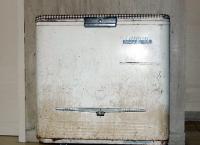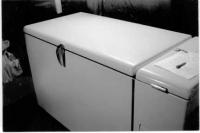Recall: Old Chest Freezer Recall, A Deadly Play Area for Children
| FOR IMMEDIATE RELEASE October 24, 2000 Release # 01-016 |
Chest Freezer Recall Hotline: (800) 267-3138 CPSC Consumer Hotline: (800) 638-2772 CPSC Media Contact: Ken Giles, (301) 504-7052 AHAM Contact: Jill Notini, (202) 872-5955 Ext. 318 |
CPSC, Appliance Manufacturers Announce Voluntary Recall Initiative for Old Chest Freezers - A Deadly Play Area for Children
WASHINGTON, D.C. - In cooperation with the U.S. Consumer Product Safety Commission (CPSC), the Association of Home Appliance Manufacturers (AHAM) and its refrigerator/freezer manufacturing members are announcing a voluntary recall initiative to prevent suffocation deaths to children who become trapped inside non-working chest freezers in homes.Up to 9 million chest freezers were manufactured between 1945 and 1970 before voluntary safety standards went into effect allowing freezers to be opened from the inside. Although some manufacturers had freezers that were in compliance prior to the 1970 standards, most old chest freezers have latches that can trap a child. Children playing "hide-and-seek" have found the non-working freezers a deadly place to hide. When the lid closes, children can become trapped inside and suffocate - usually in less than ten minutes.
Consumers should properly dispose of these non-working freezers immediately or disable the latch if disposal is impossible. AHAM has set up a special toll-free number (800) 267-3138 from which consumers will be sent detailed information on identifying the affected units and how to dispose of them or disable the latch. Even if a consumer has a pre- 1970 chest freezer that is working, they should still call the toll-free number to get information on what to do when the freezer is no longer working. Consumers also can receive information at http://www.aham.org/freezer_safety.htm.
Tragically, 27 children have died from suffocation between 1980 and 1999 after becoming trapped in the freezers. The deaths occurred in non-working freezers stored outside, in basements or garages. Victims ranged in age from two to fourteen. In many cases, more than one child suffocated inside the freezer.
The freezers that are part of this program were made before 1970 by more than 40 manufacturers, a number of whom do not exist today. Consumers can determine if their chest freezer poses a hazard by trying to open the freezer without using the handle. If the freezer can be opened by pulling up on sides of the lid, it is not a hazard. If the lid only opens by using the handle, it needs to be properly disposed of or disabled.
"Many of these old freezers are still sitting in people's basements or abandoned in backyards," said CPSC Chairman Ann Brown. "This is an innovative cooperative effort that helps get safety information to consumers and saves lives."
"We are hopeful this partnership between manufacturers and the government will help save children's lives. We urge all consumers with an affected freezer to dispose of the unit as soon as possible," said Joseph M. McGuire, president of AHAM.

